UK Games Expo 2012
Pevans sees the new games in Birmingham
My report is written as a narrative to be read through and focuses on the new (to me) board games I saw and, occasionally, played. You can use the indexes below to take you to specific exhibitors or games.
It is also available as a PDF document: UK Games Expo 2012 report (1.3 Mb). (You will need Adobe Reader to view this document – use the link to download it if you need it.)
List of games
| Title | Publisher/Distributor | Pevans's rating* |
|---|---|---|
| Agricola: All Creatures Big and Small | Lookout Games | |
| Anyways | Ragnar Brothers | 7/10 |
| Bronze | Spiral Galaxy Games | |
| Conflicting Kingdoms | DeckVoid | |
| Doctor Who card game | Cubicle 7 | |
| Foundation | Cubiko | |
| Great Museum, The | Medusa Games | |
| Medieval Mastery | Chaos Publishing | 7/10 |
| Moral Conflict | Playford Games | |
| Panic Lab | Coiledspring Games | |
| Pirates of Nassau | Gung Ho Games | 8/10 (at Spiel) |
| Project Pandora: Grim Cargo | Mantic Games | |
| Snowdonia | Surprised Stare Games | |
| Socceristic | Across the Board | |
| Test of Fire | Mayfair Games | 5/10 |
| Thunderstone Advance | AEG | 6/10 |
| Warriors & Traders | NSKN Legendary Games | |
| Zoom Zoom Kaboom! | Hopwood Games | |
| * This is my highly subjective preliminary rating and is only given for games I played once | ||
List of exhibitors
| Across the Board |
| AEG |
| Chaos Publications |
| Coiledspring Games |
| Cubicle 7 |
| Cubiko |
| DeckVoid |
| Gung Ho Games |
| Hopwood Games |
| Lookout Games |
| Mantic Games |
| Mayfair Games |
| Medusa Games |
| NSKN Legendary Games |
| Playford Games |
| Ragnar Brothers |
| Spiral Galaxy Games |
| Surprised Stare Games |
Pevans's report
I was getting all nostalgic on the train going up to Birmingham. With the Expo moving to the NEC next year and MidCon already gone to Derby, this may well have been the last time I did this particular train ride. Living close to a Chiltern Lines station, I can take a train into the centre of Birmingham. Okay, it’s not a particularly fast train, but it still takes less time than traipsing across London to Euston and getting the fast train. However, next year I may well be doing just that.
It was also a bit nostalgic crossing the threshold into the Clarendon Suites. I have got quite used to the rabbit warren of rooms on different levels and will even miss the displays of Masonic regalia that fill the balconies. However, I fully expect next year’s venue, the Hilton Metropole at the NEC, to be more practical. As I understand it, the Expo will be in just a couple of rooms, making it easier for people to find things, but providing more space than it has at the moment with room to expand further in the future.
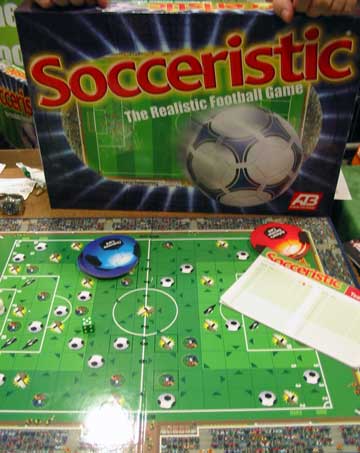 Anyway, back to this year’s event. As always, the Expo was a good mix of all sorts of games with exhibitions and tournaments, lots of traders, publishers showing their new games and demonstration games to join in. Most of the exhibitors were from the UK, of course, but there were a smattering of European publishers and Mayfair Games came over from the US. I stuck to the board (and card) games,
aiming
to take a look at all the new ones, and these are what I report on here. As always, my comments are based on just this initial look at each game. I’ve organised my report in alphabetical order of publisher and mark those games I have played on my highly subjective scale.
Anyway, back to this year’s event. As always, the Expo was a good mix of all sorts of games with exhibitions and tournaments, lots of traders, publishers showing their new games and demonstration games to join in. Most of the exhibitors were from the UK, of course, but there were a smattering of European publishers and Mayfair Games came over from the US. I stuck to the board (and card) games,
aiming
to take a look at all the new ones, and these are what I report on here. As always, my comments are based on just this initial look at each game. I’ve organised my report in alphabetical order of publisher and mark those games I have played on my highly subjective scale.
Across the Board was a new name to me, but they have already published two games. Quadraughts is a four-player Draughts variant. I think that says it all. Socceristic is “The Realistic Football Game”. Designed by the affable and enthusiastic Keith Mallet, it’s played across a board that depicts a football pitch. The pitch is divided into squares, each with an arrow to show the direction the ball goes next. The player in possession rolls the die and moves the ‘ball’ that number of spaces. If it lands on a ‘tackle’ space, players roll dice to see whether the defender takes the ball. If it lands on a ‘whistle’ space, the player draws a card to find out the referee’s decision. And if the ball is close enough to your opponent’s goal, you can take a shot, drawing a card (from a different deck) to see if you score.
As far as I can see Socceristic is pure luck. You don’t even choose which direction to move the ball, it’s all decided by the board. The game is nicely produced and I’m sure it can be fun to play, but it leaves me cold. For more about both these games, see the ATB website.
The UK arm of AEG was demonstrating several games, including the new edition of Thunderstone, Thunderstone Advance. (Isn’t there a ‘d’ missing there, or am I just being pedantic?) Not having come across Thunderstone before, this was all new to me. I can best describe the game as a dungeon bash using deck-building/tuning mechanisms.
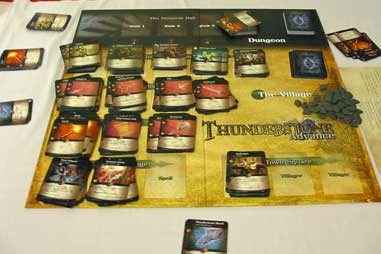 Playing Thunderstone Advance(d?)
Playing Thunderstone Advance(d?)
Thus, the aim is to defeat the monsters currently available, winning trophies, experience and victory points in doing so. To do this, you need a strong enough group of heroes and weapons in your hand of cards. Your choice each turn is to visit the village and buy cards to add to your personal deck, to enter the dungeon and take on a monster with the cards you have in hand or to try to improve your deck by discarding cards. Of course, the more cards in your deck, the harder it is to get the right cards together at the right time.
Defeated monsters may bring trophies, experience points (which can be used to improve your heroes) and victory points. In a neat touch, you add the monster card to your deck, where it’s worth victory points, but also gets in the way. While the game is about beating monsters, you are actually competing against your fellow players. The game ends when the ‘Thunderstone Bearer’ monster is defeated (or escapes). Players tot up the victory points in their whole deck and the player with the most points wins.
The fantasy theme of Thunderstone Advance is a good fit to the deck-building mechanisms of the game. It is easy to get carried away with bashing the monsters and trying to build the ultimate set of cards. The trick seems to be making sure you do enough of both. Just building the ultimate deck won’t win you the game. And you can’t carry on beating the monsters unless you do some deck building. Despite this, the game didn’t particularly appeal to me and it gets a 6/10 on my highly subjective scale. There’s plenty about the game on the AEG website.
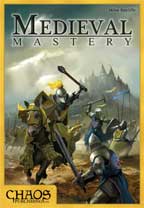 Having missed last year’s Expo, this was my first viewing of Chaos Publishing’s Medieval Mastery. Players are feudal Barons, sending out their knights to claim land. The game is played over a ‘board’ of hexagonal tiles, which provides variety to the game. The many dice in the game are not rolled, they are deployed across the board, showing the strength of players’ knights
in each area.
Each
player has their own deck of cards for their actions through the game and starts with some artefacts (special actions)
that give a flavour to their set-up and strategy.
Having missed last year’s Expo, this was my first viewing of Chaos Publishing’s Medieval Mastery. Players are feudal Barons, sending out their knights to claim land. The game is played over a ‘board’ of hexagonal tiles, which provides variety to the game. The many dice in the game are not rolled, they are deployed across the board, showing the strength of players’ knights
in each area.
Each
player has their own deck of cards for their actions through the game and starts with some artefacts (special actions)
that give a flavour to their set-up and strategy.
The initial stages of the game involve spreading out to grab vacant land – each type of land does something different, so some tiles are more valuable than others. Each area is also worth influence and the aim of the game is to be first to 13 influence points. Conflict begins pretty quickly as players have nowhere else to go once the vacant areas have been taken. Moving in to an occupied area starts a battle, which will be won by the player with the greater strength (knights plus cards). The winner takes over (or retains) the territory. The loser loses some knights – the difference in strengths – but this will often give the loser a head start in making an attack on their next turn.
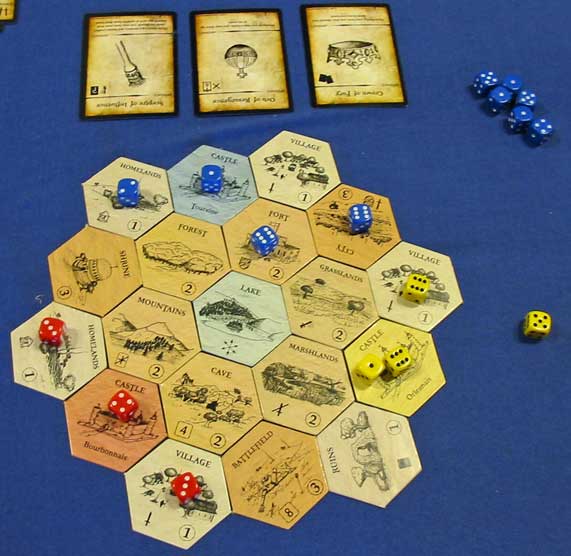 3-player Medieval Mastery in progress
3-player Medieval Mastery in progress
Medieval Mastery is a neat game illustrated with some excellent line drawings. I enjoyed playing it, but it does suffer from the problem of multi-player wargames, that it can take a long time to find a winner. The players start fairly even and the to and fro of the game only shifts a few points from player to player. Anyone who gets a significant lead will have several players (those adjacent to them) to deal with. The trick is building up enough of an advantage to be able to force the win.
Designer Miles Ratcliffe has done a good job with this, his first published game and I give it an initial 7/10 on my highly subjective scale. Chaos Publications have a second, multilingual edition of the game in preparation and expect to launch it at this year’s Spiel game fair. For more, see their website at www.chaospublishing.com.
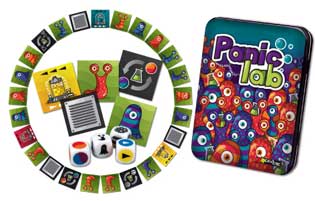 Distributor Coiledspring Games had a host of games on display, in demos and for sale. I was particularly pleased to see that they have picked up Stefan Feld’s Trajan, published by Ammonit Spiele. This was one of the more interesting titles I saw at last year’s Spiel. It’s a strategy game of the expanding Roman Empire with
a Mancala-like mechanism
at its heart.
They also had the latest from French publisher Gigamic: Panic Lab is a fast-playing card game of pattern matching. Players aim to be the fastest
to spot a card that matches the characteristics rolled on the dice. For more see the Coiledspring website.
Distributor Coiledspring Games had a host of games on display, in demos and for sale. I was particularly pleased to see that they have picked up Stefan Feld’s Trajan, published by Ammonit Spiele. This was one of the more interesting titles I saw at last year’s Spiel. It’s a strategy game of the expanding Roman Empire with
a Mancala-like mechanism
at its heart.
They also had the latest from French publisher Gigamic: Panic Lab is a fast-playing card game of pattern matching. Players aim to be the fastest
to spot a card that matches the characteristics rolled on the dice. For more see the Coiledspring website.
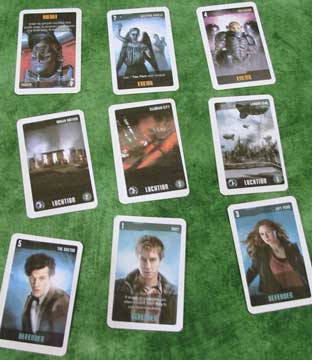 Cubicle 7 is best known as a publisher of role-playing games, notably the Doctor Who RPG. They were showing off the prototype of their Doctor Who card game, designed by Martin Wallace. The deck of cards contains good guys, baddies, locations and gadgets and players will have a mixture to play from. The idea is to use the
good guys (plus gadgets)
to defend
your own locations while attacking other players’ locations with the baddies. However, the cards you don’t play you pass to the next player…
Cubicle 7 is best known as a publisher of role-playing games, notably the Doctor Who RPG. They were showing off the prototype of their Doctor Who card game, designed by Martin Wallace. The deck of cards contains good guys, baddies, locations and gadgets and players will have a mixture to play from. The idea is to use the
good guys (plus gadgets)
to defend
your own locations while attacking other players’ locations with the baddies. However, the cards you don’t play you pass to the next player…
Add in that you have a varying number of actions each turn and what initially appeared to be a simple game gets rather tricky. Play continues until the deck runs out and players score for their own locations that they have defended and other players’ that they have conquered. On first acquaintance, this looks terrific and I look forward to its appearance “later this year”. See the Cubicle 7 website for more.
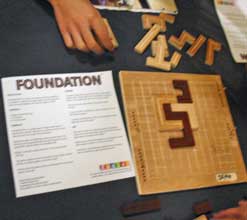 As well as demonstrating his original game, Cubiko, Gavin Birnbaum was showing off the latest from Cubiko the publisher. Foundation is a clever two-player abstract game in wood. The square board is divided into a square grid. On to this players in turn place wooden shapes in their colour – each player starts with the same shapes in their
set. The first challenge,
as the game goes on, is simply finding room for another piece – pieces left over at the end sore minus points!
As well as demonstrating his original game, Cubiko, Gavin Birnbaum was showing off the latest from Cubiko the publisher. Foundation is a clever two-player abstract game in wood. The square board is divided into a square grid. On to this players in turn place wooden shapes in their colour – each player starts with the same shapes in their
set. The first challenge,
as the game goes on, is simply finding room for another piece – pieces left over at the end sore minus points!
However, this is only the start as players score points or the number of pieces adjacent to the new one (regardless of whose they are). So you are looking to score points, but also to make opportunities for scoring more points later. Of course, if your opponent spots what you’re preparing they may well take the opportunity first – or simply block it.
Foundation is another apparently simple game that actually requires a bit of thought. Gavin has produced a highly limited edition of the game, each copy being handmade. The first edition sold out at the Expo and a second edition is in production. For details see the Cubiko website.
DeckVoid is the publisher of Conflicting Kingdoms, another game making its debut at the Expo. The game is described as a trading/collectible card game where the cards make up the board. In the fantasy setting, players’ avatars battle it out across the locations provided by the cards played. Players use more cards to make an attack, fuelled by the ‘elements’ provided by their current location. Their target plays cards to defend and either player may lose ‘life’ or collect ‘rewards’. The game ends when only one player is left – the winner!
As you can see from that (brief) description, the bulk of the game is in the cards (players also get a metal figure as their avatar). These provide the atmosphere, the challenges and the details of the game. At first glance, the game looks ordinary enough, but it really needs to be played to get any idea of how well it works. Luckily, DeckVoid have given me a review copy, so watch this space. To find out more now, try the Conflicting Kingdoms website.
Gung Ho Games were showing The Pirates of Nassau, another game I saw (and played) at Spiel last year – see Pevans's Spiel report for my comments and the Gung Ho Games website for more from them.
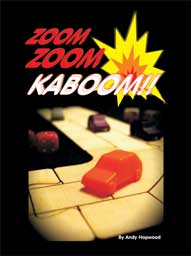 Andy Hopwood is the man who devised Mijnlieff. His latest, from Hopwood Games, is Zoom Zoom Kaboom!, which won the Expo’s Best Board Game award. It’s a clever push-your-luck race game. Not only do you have to decide how many dice to roll for your speed, you must also work out whether to risk the “Ka-Boom!” cards. The final twist is that players have to race
along the track
and then back again. This means that the first one to get to the end has to face the oncoming traffic!
Andy Hopwood is the man who devised Mijnlieff. His latest, from Hopwood Games, is Zoom Zoom Kaboom!, which won the Expo’s Best Board Game award. It’s a clever push-your-luck race game. Not only do you have to decide how many dice to roll for your speed, you must also work out whether to risk the “Ka-Boom!” cards. The final twist is that players have to race
along the track
and then back again. This means that the first one to get to the end has to face the oncoming traffic!
On top of that, each player has their own ‘character’, providing different advantages and penalties. And there are several more tactical elements. I didn’t get to play the game at the Expo, but it looks to be huge fun. It was certainly generating a lot of laughter in the evening gaming sessions at the hotel. Having dealt with all the advance orders, Andy now has copies of the game available from the Hopwood Games website.
Hanno Girke of Lookout Games was one of the European contingent at the Expo. He was demonstrating Agricola: All Creatures Big and Small. This is Uwe Rosenberg’s re-working of his highly successful Agricola as a two-player game. It concentrates on animal husbandry, dispensing with the mixed nature of the farms in the original game. This appears to be a much simpler game – it’s supposed to play in 30 minutes, for one thing. I didn’t get the chance to try it, though. The English language edition comes from Z-Man Games – the Lookout Games website is in German.
Mantic Games was another new name to me. It turns out the company produces miniatures rather than board games. However, the latest offering is Project Pandora: Grim Cargo, pitting humans against the aliens boarding their spaceship. The game is played on a ‘board’ assembled from tiles showing sections of the spaceship. The opposing forces are, of course, some of Mantic’s figures, battling it out for control of the spaceship according to the requirements of the particular scenario being played. I gave it a miss.
I’ve already mentioned that US publisher Mayfair Games was attending. They were demonstrating several games, showing off the breadth of their range. Top of the heap was Whitewater, a fun game of white water rafting. It is not, as I originally supposed, a re-working of Canyon, but a new game from Frederic Moyersoen. Players have to navigate their rafts downriver, avoiding the hazards and trying to keep everyone on the raft. The twist is that the crew of each raft is made up of several players’ pawns. This is aimed at a younger age group than most of Mayfair’s titles and has an emphasis on family play.
Also being played was Nuns on the Run, another game by Frederic Moyersoen, this time from 2010. It’s a hidden movement game with the players as novices trying to sneak around the convent without being spotted by the Abbess. This is another fun game for family play, but makes a decent filler for gamers too.
The game I sat down and played was Test of Fire, a two-player wargame of the first battle of Bull Run (the opening engagement of the American Civil War). Designed by Martin Wallace, Test of Fire was published last year, but this was my first encounter with it. The board shows the major geographical features (notably the hills and the Bull Run river itself) of the battlefield and is divided into areas. Players’ infantry and artillery units are rectangular cardboard counters and start in their historical positions (there is also a ‘free deployment’ scenario).
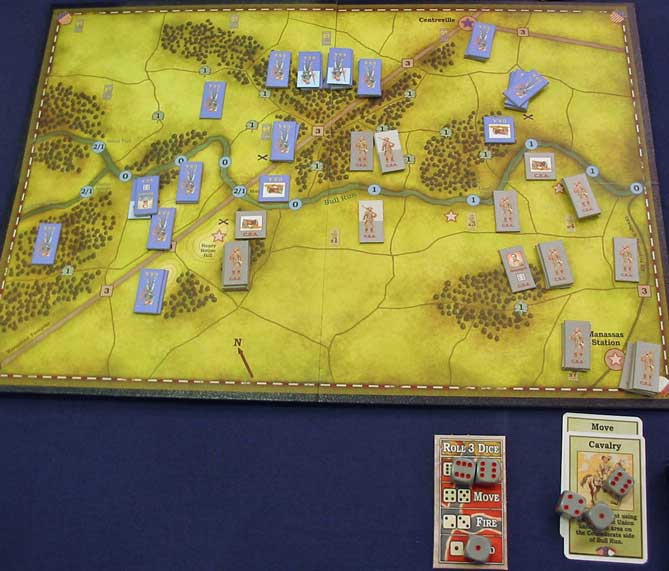 Test of Fire in play:
Test of Fire in play:
an early Rebel advance across the Bull Run won't last.
Note the dice and cards.
The game is controlled by rolling dice. The numbers rolled give the players’ actions for the turn. Rolling a ‘1’ lets you draw a card, for example. Other numbers allow players to move units or fire their artillery, while ‘6’ is wild and players have their choice of action. The cards provide players with a bonus or some special action. For example, there are no units on the board for Cavalry, they are provided by the cards.
Combat happens when opposing units move into the same area. It’s resolved by rolling more dice, and then rolling again to see the effects of any ‘hits’. Opposing units may be damaged or forced to retreat. Damaged units flip to their other side and are removed if they’re hit again. However, it’s more likely that units will retreat than take damage, especially when hit by artillery. This means the battle is more about the to and fro of units than destroying them.
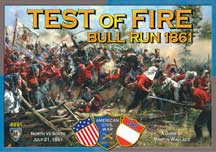 I found the game unsatisfying despite winning as the Confederates (by denying their objectives to the Union side – I was particularly pleased to emulate Stonewall Jackson in defending Henry House Hill.) It just seemed there was an awful lot of dice rolling for very little effect. This may be in keeping with the battle (most of the troops were very green), but it didn’t grab me. Test
of Fire
gets an initial 5/10 on my highly subjective scale.
I found the game unsatisfying despite winning as the Confederates (by denying their objectives to the Union side – I was particularly pleased to emulate Stonewall Jackson in defending Henry House Hill.) It just seemed there was an awful lot of dice rolling for very little effect. This may be in keeping with the battle (most of the troops were very green), but it didn’t grab me. Test
of Fire
gets an initial 5/10 on my highly subjective scale.
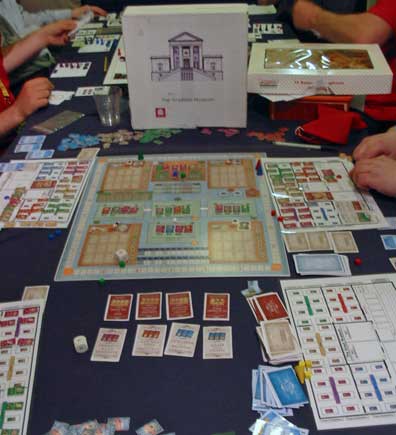 Medusa Games is the imprint of Expo organiser Richard Denning, whose first game, Great Fire of London 1666, went down very well. At this year’s Expo the Medusa team had a prototype of Richard’s new game, The Great Museum. This pits the players against each other as curators attempting to collect the best artefacts for their museum.
It looked interesting,
and I hope
to see more of it at other events. For more, see the Medusa website.
Medusa Games is the imprint of Expo organiser Richard Denning, whose first game, Great Fire of London 1666, went down very well. At this year’s Expo the Medusa team had a prototype of Richard’s new game, The Great Museum. This pits the players against each other as curators attempting to collect the best artefacts for their museum.
It looked interesting,
and I hope
to see more of it at other events. For more, see the Medusa website.
NSKN Legendary Games from Romania was another of the European outfits with a presence at the Expo. Their main emphasis was the terrific Warriors & Traders board game which they released at Spiel last year. As the name suggests, this is a game of war and commerce. It's played out on a board showing part of western Europe (or eastern Europe if you play on the other side!). Players all start with the same resources and there are no random elements in the game as they develop their economies, build up their armies and seek to dominate Europe.
As you'd expect, the game has a substantial rulebook. However, play doesn't go on for ever as the game is limited to just 10 turns (though a lot can happen in a turn). And it can finish sooner if one player is running away with it. Players get points from military success, from provinces and for money and the most points wins the game. Warriors & Traders was attracting a lot of attention at the Expo, not least because of its attractive artwork and high production. It remains high on my list of games to try.
NSKN were also showing prototypes of other games they are working on. Wild Fun West is a card game of developing a town in the Wild West. While players work together to add buildings to the town, each has a secret objective and wants particular buildings constructed. Exodus: Proxima Centauri is rather different: it’s space opera! In some ways the game might be thought of as similar to Warriors & Traders as both involve building an empire. However, the mechanisms in the two games are very different with Exodus having a political element as well as incorporating scientific research. I look forward to seeing more of both games. You can keep up with NSKN Legendary Games from their website.
Playford Games had the series of Moral Conflict games on display, mostly in prototype form. These games cover the Second World War in multi-player form, their distinguishing feature being the addition of a moral element. Each participant in the conflict has a moral index that is one of the factors limiting their actions. Thus the good guys will suffer if they do things like attacking neutral countries or dropping an atomic bomb – too much of that kind of thing and they will not be able to win.
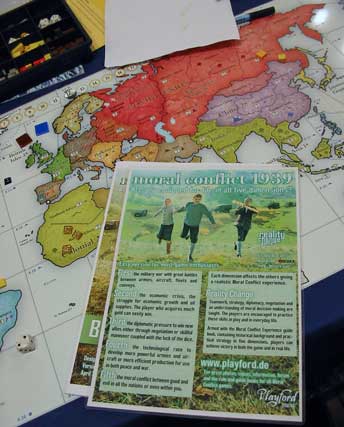 In its simplest form (Moral Conflict 1939), the game is Risk-like. Players are trying to conquer regions of the world map with their military forces (wooden pieces). Battles are fought on a tactical ‘battle board’ with just four different types of unit and resolved using six-sided dice. It takes up to five players (aged 12+) and can be played
in about an hour (either across the whole world or concentrating on a specific area).
In its simplest form (Moral Conflict 1939), the game is Risk-like. Players are trying to conquer regions of the world map with their military forces (wooden pieces). Battles are fought on a tactical ‘battle board’ with just four different types of unit and resolved using six-sided dice. It takes up to five players (aged 12+) and can be played
in about an hour (either across the whole world or concentrating on a specific area).
Moral Conflict 1940 adds extra detail, using a larger board with more areas and involving more types of military unit. 12-sided dice are used to give greater complexity to battles. It is for up to six players (aged 13+) and takes 90 minutes or so to play. Moral Conflict 1941 is the full game with a bigger board again. It is aimed at “sophisticated gamers” and uses 20-sided dice for battles that involve a dozen different types of military unit.
This is a huge project, so I am not surprised that it is still under development. I am fascinated to see how the moral dimension works and whether it will, in fact, constrain players to act ‘morally’ within the game. There is, of course, a strong educational element to the game with additional material available for schools to use. The first of the games is available now with others being released this year and next. To find out more, take a look at the Playford website.
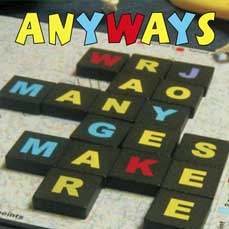 The Ragnar Brothers’ new game was something of a departure: Anyways is a word game. Players have just four square letter tiles in their hand (they start with two consonants and two vowels, but can vary the mix as they draw new tiles). They only play one tile in their turn, placing it adjacent to tiles on the square board. They then score points for the new words they’ve
made. Words can
go vertically,
horizontally or diagonally across the board and can be read forwards or backwards.
The Ragnar Brothers’ new game was something of a departure: Anyways is a word game. Players have just four square letter tiles in their hand (they start with two consonants and two vowels, but can vary the mix as they draw new tiles). They only play one tile in their turn, placing it adjacent to tiles on the square board. They then score points for the new words they’ve
made. Words can
go vertically,
horizontally or diagonally across the board and can be read forwards or backwards.
The letter tiles are colour-coded for their points value (vowels and common consonants are 1 point, other consonants go up to 4 points, depending on how common they are in English words). A player’s score is the value of the tile played times the length of the new words. That’s every new word they’ve made by placing the one tile. Some arithmetic is required! It is immediately obvious that the game requires a bit of thought as you’re looking for the optimum place for a single tile so that it scores multiple words. Of course, the higher the value of the letter, the fewer words you’re likely to be able to make.
There are lots of word games about, but Anyways is a clever twist on the theme. My biggest problem was doing the sums to check all my possible scores from all my possible plays and then remembering which one was the high score. It gets 7/10 on my highly subjective scale. The Ragnars have produced an initial, limited edition of 500 copies and they are available from the Ragnar Brothers website.
Also on display was the artwork for the Ragnars’ next game, New Dawn, set in the Democratic Republic of Congo. This is being published with Spiral Galaxy (see below). They were also publicising the new edition of one of their earliest games, Angola, from Multi-Man Publishing.
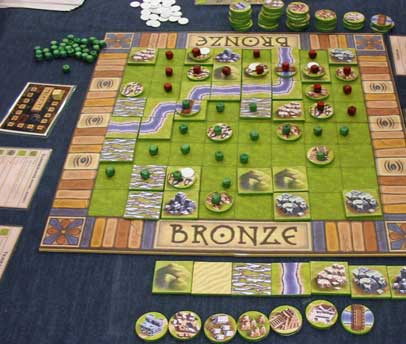 Bronze is the new game on its way from Spiral Galaxy Games and shown at the Expo in a pre-production form. It’s a two-player game of developing your ancient civilization and gaining the most territory. The artwork is good and the game looks interesting – despite my limited interest in two-player games. There’s nothing on the Spiral Galaxy Games website about it, but there is information on Facebook (BronzeBoardGame) and a computer version at www.shrapnelgames.com. Bronze is intended
to be a Kickstarter project.
Bronze is the new game on its way from Spiral Galaxy Games and shown at the Expo in a pre-production form. It’s a two-player game of developing your ancient civilization and gaining the most territory. The artwork is good and the game looks interesting – despite my limited interest in two-player games. There’s nothing on the Spiral Galaxy Games website about it, but there is information on Facebook (BronzeBoardGame) and a computer version at www.shrapnelgames.com. Bronze is intended
to be a Kickstarter project.
With their distributor hat on, Spiral Galaxy were also showing a prototype from Czech Games Edition that I thought was called "Mayan Ages". The game features of interlocking cog wheels on the board and I have no idea whether CGE will find a way to manufacture this economically. I guessed that the wheels represented the various cycles of the Mayan calendar, but I didn’t get to try the game. The CGE website does not enlighten me, but does give the name of the game as Tzolkin: the Mayan Calendar and the designers as Daniele Tascini and Simone Luciani.
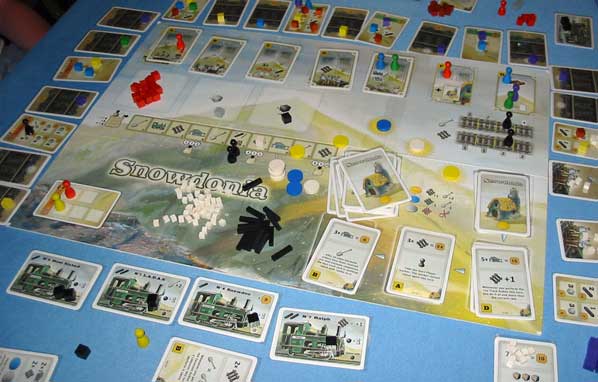 Surprised Stare Games were concentrating on Sebastian Bleasdale’s On the Cards, which I covered in To Win Just Once 120 as part of my report from Spiel ’11. However,
they also had a prototype
version of
their next board game, Snowdonia, available for people to try. The game is about the building of the mountain railway up Mount Snowdon. Players are rival work gangs contributing to the construction and subject to the constraints of the weather (it’s Wales – it rains!). Designed by Tony Boydell, Snowdonia looks terrific, with some fierce competition between players for the available actions. I look forward to seeing the finished article – it’s expected for the Spiel games fair in October.
Surprised Stare Games were concentrating on Sebastian Bleasdale’s On the Cards, which I covered in To Win Just Once 120 as part of my report from Spiel ’11. However,
they also had a prototype
version of
their next board game, Snowdonia, available for people to try. The game is about the building of the mountain railway up Mount Snowdon. Players are rival work gangs contributing to the construction and subject to the constraints of the weather (it’s Wales – it rains!). Designed by Tony Boydell, Snowdonia looks terrific, with some fierce competition between players for the available actions. I look forward to seeing the finished article – it’s expected for the Spiel games fair in October.
Treefrog was disappointingly low key this year with no new game for us (but, judging by the number of games he’s designed for other publishers, Martin Wallace has been rather busy).
That’s it for my tour round the publishers. While the main event was in the Clarendon Suites during the day on Saturday and Sunday, there was plenty of open gaming in the hotel on Friday and the evenings as well. The organisers provide a games library and this is an important part of the Expo –particularly for gamers like me.
I played some familiar games over the weekend, putting on my teaching hat to introduce people to Corné van Moorsel’s Sun, Sea & Sand. I also played Abandon Ship for the first time. This is a fun family game from AEG that was designed by Reiner Knizia (so it does have some subtleties). If you’ve ever seen it, you’ll know the game from its clever sinking ship mechanism.
As I mentioned at the start, UK Games Expo is moving to a new venue next year, having outgrown this one. I have every expectation that the event will continue getting bigger and better and I certainly intend to be there. To keep up to date, see the UK Games Expo website.
This article was first published (in an edited form) in To Win Just Once issue 126 (July/August 2012).
